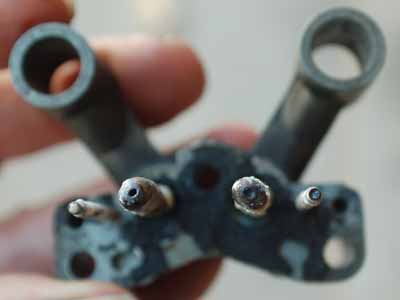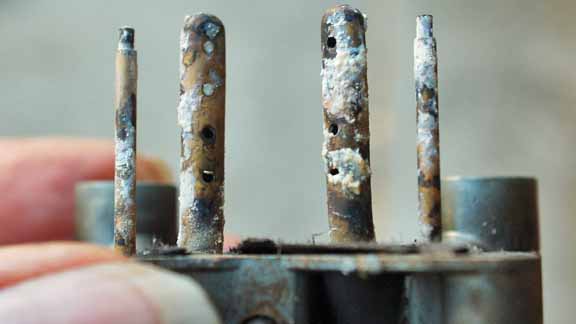Boaters leery of push for E15 fuel
This is a column from Robert Montgomery for ESPN Outdoors. As a Senior Writer for BASS Publications, Montgomery has written about conservation, environment, and access issues for more than two decades.
Photo Courtesy BoatUS: Marine engines have not fared well with E10, and BoatUS calls for more testing before E15 approval.
Clogged carburetors, crumbling components, ruptured fuel lines. Boats stalled at sea, lives put at risk, and thousands spent on repairs.
That’s the legacy of gasoline with 10 percent ethanol (E10) used to power marine engines.
And the nightmare is poised to get worse, according to industry experts.
That’s but one of the reasons that boating-related groups and an unlikely array of allies are asking the federal government to proceed with caution as it considers increasing the allowable ethanol content of gasoline from 10 percent to as much as 15.
And that’s why BoatU.S. is encouraging anglers and other boaters “to speak out now at www.BoatUS.com/gov and tell President Obama that scientific testing on E15 must precede EPA’s decision and not come at a later date.”
Currently, it appears that the Environmental Protection Agency will proceed progressively, first recommending that gasoline with up to 50 percent more ethanol (E15) be manufactured for newer vehicles, probably those manufactured from 2007 to date.
E10 (10 percent ethanol) will continue to be produced for older on-road and on-water vehicles, as well as lawn mowers, chainsaws, ATVs, and other machines with internal combustion engines. The go-ahead could be given within the next two weeks, following a recent analysis of E15 by the Department of Energy, which did not make a specific recommendation.
This is occurring now because a Renewable Fuel Standard set in 2007 by the Energy Independence and Security Act requires that 36 billion gallons of alternative fuel, such as ethanol, be incorporated into markets by 2022. Only about 11 billion gallons were used in 2009.
“That market is hitting a wall, so without a transition to E15, it will be difficult to stay on track with the Renewable Fuel Standard requirement,” reported Popular Mechanics.
Additionally, corn growers and ethanol producers, with a glut of product and powerful friends in Washington, D.C., are pushing for increased use. They have reached a “blend wall” and cannot sell all that they are required to produce. They are joined by those who argue that using more ethanol will lead to cleaner-burning, home-grown fuels that will lessen dependence on foreign oil.
“But the weirdest coalition on Capitol Hill is saying to put on the brakes. There needs to be more testing,” said BoatU.S.’s Scott Croft, who added that he knows of no completed tests on E15’s effects on marine engines, new or used.
Plenty of evidence exists, however, in the aftermath of E10’s introduction with little or no testing, and boat owners still are suffering through the consequences of using this blend in older engines.

Photo Courtesy BoatUS: The corroded and clogged carburetor jets are the result of using E10 in a 1987 Penn Yan cuddy with a six cylinder inboard engine, one boater said.
For one thing, ethanol attracts moisture and marine engines are vented to the outside, allowing entry. The alcohol can absorb some of the water that condenses on the walls of the gas tank, but the rest settles to the bottom and eventually is sucked into the engine.
“Ethanol is a really good solvent,” Croft added. “It scours gunk from tank walls and blocks fuel lines. It dissolves rubber and plastic parts.”
Down in Florida, Scott Erwine at Marine Supply/The Boating Center in Winter Haven said that his business often sees just such damage. “Ethanol is alcohol that is added to the fuel and the problem in the marine industry is that a lot of rubber components start to break down in fuel pumps and fuel lines. Also, in older boats, non-ethanol fuel was originally run through it. Now you use a cleaning agent through it and it starts to gum up everything, like the fuel injectors, carburetors, and electric fuel pumps.”
In Maryland, boat owner John Ward said that his boat, a 21-foot 1987 Penn Yan cuddy with a six-cylinder inboard, “ran fine until we started using E10.
“We now routinely tear down the carb to clean out the enzymes, etc.,” he said. “And we keep carb rebuilding kits on hand for when we damage the delicate gaskets, etc. during rebuild.”
Although he boats primarily along the western shore of Chesapeake Bay, he plans to run across the bay because he has learned that some stations on the Eastern Shore still sell gasoline without ethanol.
“We have to make a six- or seven-hour round trip to get gas that won’t damage our engines,” he said. “Is this what the EPA has in mind?”
Add the E15 option and that unblended fuel probably will be even harder to come by for Ward, as well as millions of others who own boats, lawnmowers, snowmobiles, and other machines not designed to handle 15 or even 10 percent ethanol.
At present, about 75 percent of fuel supplies contain up to 10 percent ethanol. Gas stations aren’t likely to add more pumps and tanks to accommodate E15 and maybe even E12, especially during these tough economic times. Instead, they’ll modify their offerings.
“A lot of anglers fill up their tanks (for boats) on their way to the lake,” Croft said. “This (adding E15) could cause serious distribution issues. Also, the higher ethanol could go into the regular gas and the 10 percent into the higher octane, so that you’d have to pay more if you don’t want the E15.”
And you could risk putting in a higher octane than recommended by the manufacturer of your boat.
“If there are two blends of ethanol available, along with multiple octanes to chose from, consumers are set up with more decisions to make, and there is a much larger possibility of mis-fueling,” BoatU.S. said.
Consumers in general will have to become “gasoline detectives,” according to www.followthescience.org, the broad-based coalition that is lobbying Congress for more thorough and objective testing of higher ethanol fuel before it is approved.
“They will need to know which model years can run on E15 and which cannot, and even then — since the testing so far is not comprehensive — they won’t know for certain whether it’s safe. Consumers will need to know not to fuel trailered boats or gas containers from the same E15 pump dedicated to late-model cars and trucks.”
Including groups ranging from BoatU.S. to the Natural Resources Defense Council to the National Chicken Council, the coalition also is concerned about increased ethanol production and use as they relate to consumer safety, food supply, water pollution, and the environment in general.
For example, growing more corn for ethanol increases use of fertilizers, which wash into rivers and streams and contribute to expanding dead zones in and around the mouth of the Mississippi and other rivers that empty into the oceans. Plus, each gallon of ethanol produced creates more than 10 gallons of sewage-like effluent, while requiring 1,700 gallons of water.
Critics also say that ethanol is not an efficient fuel.
“Corn-based ethanol requires 54 percent of the energy to process the corn into ethanol and 24 percent to grow the corn required for this process,” said, Dr. Venkat Lakshim, editor of Energy Digital, a website for energy professionals. “As a result, there is a return of only 30 percent or so of the energy, making this inefficient as compared to conventional gasoline (500 percent — produces five times the energy required to produce it.).”
Still, the federal government has decided that ethanol is to the fuel of the future in this country. What’s still in play is how much ethanol will be used in gasoline and how quickly.
“We are still confident that we submitted enough data that they can go to E15 in all gasoline engines,” said Tom Buis of Growth Energy, one of a group of farming and biofuels interests pushing the EPA. “We’re confident that the (government) testing will confirm what we’ve known all along.”
But that’s not the view of the 39 groups in Follow the Science, nor is it indicative of the experiences that thousands have had with E10.
“Many boaters, having suffered through the last ethanol transition to E10, agree that we should learn from recent history and first completely understand what the new fuel will do before approving its use in boats,” said BoatU.S.’s Margaret Podlich. “It may turn out to be harmless, but what if it’s not? What happens if safety is affected or boaters are forced to pay for expensive repairs? Remember that most boat engine warranties are void when using ethanol beyond the 10 percent level.”

